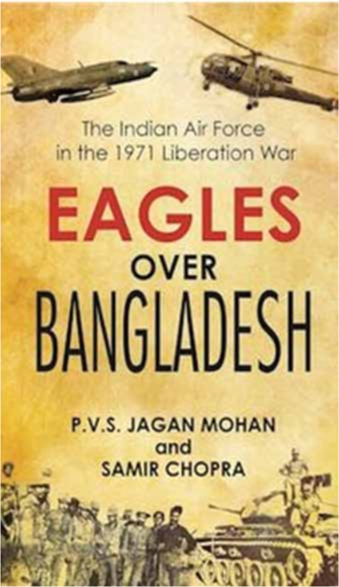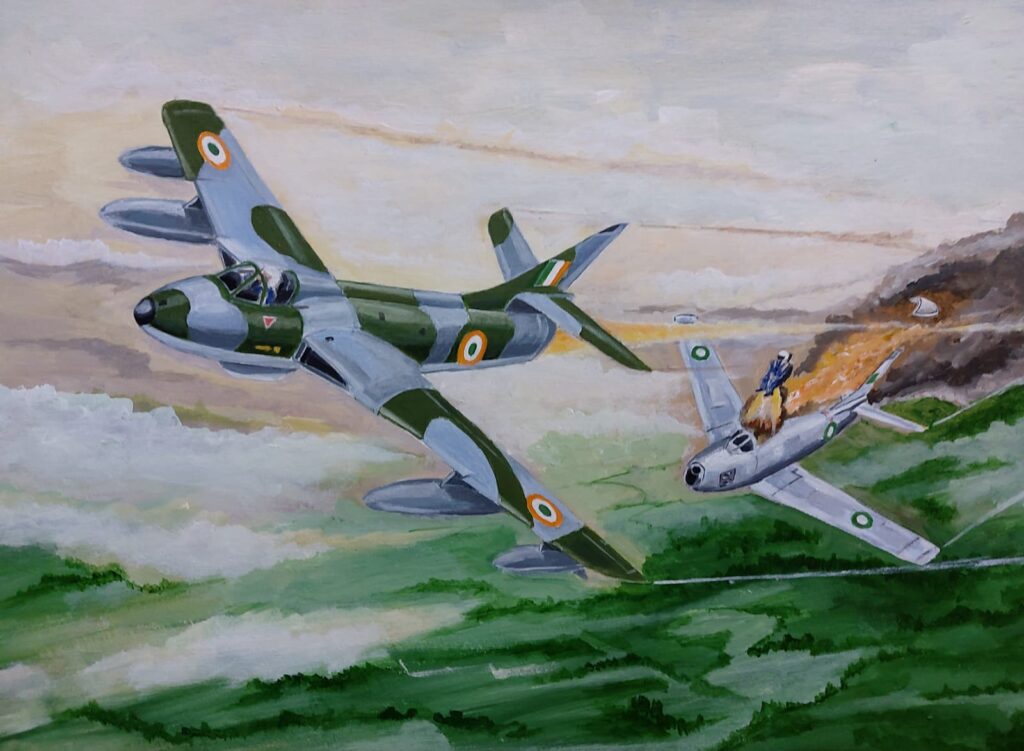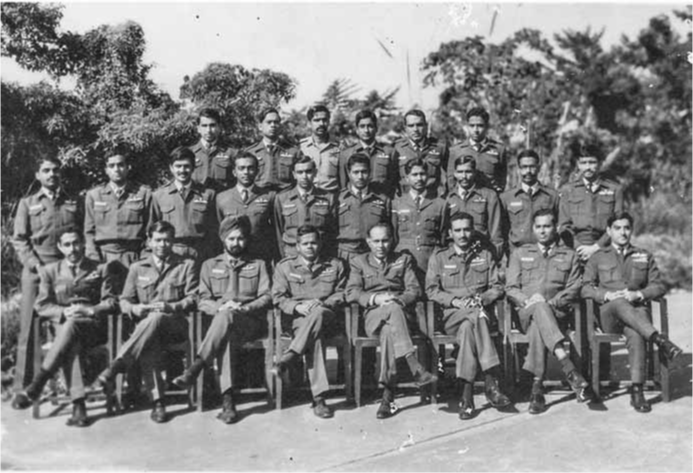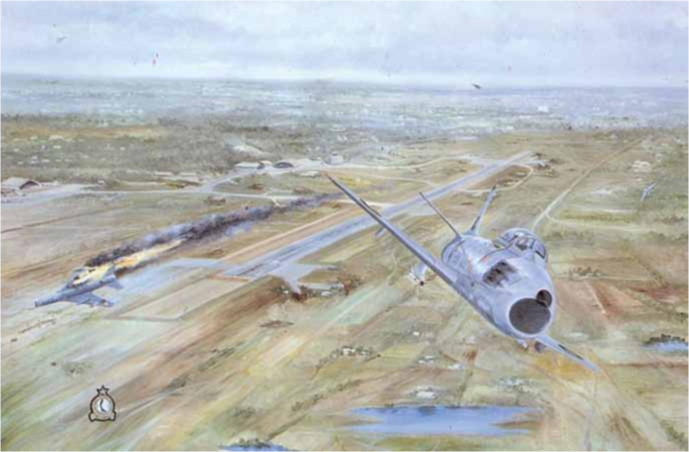Review: Eagles Over Bangladesh, 1971 Indo-Pak War

“Eagles Over Bangladesh”, the history of the Indian Air Force in the 1971 Indo-Pak war in the eastern front for the liberation of East Pakistan and the birth of a new nation, Bangladesh, is a book that was at least three decades overdue. Undeniably even from the opponents, this was perhaps the finest hour of the Indian Air Force, which recovered rapidly from the stalemate of the 1965 war and applied the lessons learnt in that war to achieve a classic air supremacy which paved the way for a quick and decisive victory before the big powers or other interested parties could intervene, at the least on the eastern front, and albeit over a much weaker foe, leading to the liberation and formation of Bangladesh. Thus, the compilation of all the events leading to this war and the ones orchestrated by the Indian Air Force during this war is something that the Indian Air Force should have itself undertaken or sponsored soon after the war not only as a record of its most glorious chapter but also for posterity for future generations of airmen and military historians to learn, debate and refine with detailed analysis through subsequent research.
Jagan Mohan and Samir Chopra are already well known in aviation circles, at the least in South Asia, having earlier authored the book on the Indo-Pakistan air war of 1965. Jagan, particularly, is known as the repository of all the information on most major air forces in South Asia, and particularly the Indian Air Force, having acquired the reputation for being the one-stop shop for information on the Indian Air Force. The years of pain staking research that these two have gone through to bring out this book is obvious to anyone who goes through it even cursorily. The effort is even more commendable since the events described in the book took place over four decades earlier and time tends to make official records difficult to find and also to erase and distort many memories. The book is, therefore, not just a tribute to all those who participated in this war but also to the determination and indefatigable energy of the two authors which would be of great interest to all those connected with aviation and military history. I, for one of those having participated in this war in the eastern front, found the book difficult to put down, eager as I was to read through the events of the next day and relate them to my recollection of the events of the war.
Though the efforts put in by Jagan Mohan and Samir Chopra to collect and compile the historical material into a narrative is highly commendable, being the first of its kind to cover the air war on the eastern front, it must be placed on record that in some places, the authors seem to have relied on the recollections of just one or two individuals instead of getting the complete story from the people involved, particularly the younger lot of formation members whose memory was likely to be more reliable. This lacuna has led to some inaccuracies in the narrative of events and sometimes raises doubts on the actions taken by the individuals as well as the claims and counter claims. I put this out more as a suggestion for any future research into this war and for strategists to derive better conclusions from the events. Since I was involved in only a limited portion of the war and that too essentially from one base, Hasimara, I can quote some examples from there to support this suggestion. The first one, and perhaps the most important one, comes from the narrative of the attack on the Governor’s house of 14 December 1971 described from page 330 of the book where it states that the first pair of Hunters from Hasimara, led by “Suppi” Kaul only carried guns. By then, with complete air superiority over East Pakistan, we were flying with impunity at medium levels, both to increase our radius of action with additional armament load as also to improve visibility and sighting of targets while staying above ack-ack and small arms fire. All four aircraft flown by both pairs thus carried T-10 rockets and a full load of 30mm front guns. We also arrived over target at about 15000 ft and descended to 6000 ft in our orbit to locate the Governor’s house with reference to the tourist map and position ourselves for an attack on the largest window/door on the first floor just right of the main entrance with the dome over it where we expected the meeting room/conference hall to be. I clearly recall seeing all our rockets go clean through this window because of the steep dive we were in from about 6000 ft in the first pass and fired a long burst of guns at the same spot in the second pass. While initially exiting at high speed and low levels to make tracking by anti-aircraft difficult, I also clearly recall a horde of onlookers on the Intercontinental hotel and we went so close to it that I could almost see their faces. I am sure they must have been wondering if we would open up our guns on the hotel too since initially we were pointing right at them. I spoke to “Suppi Kaul” about the inaccuracies in this narrative and he agreed with me.
The other incident is the one described on Page 276 of the book on Flying Officer Rajesh “laloolee” Lal’s forced landing at Cooch Behar. I was the leader for that mission and still clearly recall the entire sequence of events. Just after we finished the attacks and turned northwards towards home, Laloolee called up to say he had lost power and even at full throttle, he was barely getting 210 Knots at 3500 odd ft that we had pulled up to after the attacks. Laloolee wanted to eject immediately but I told him we had a zero-level ejection seat and we could wait a little before pulling the handle. I asked Laloolee to maintain course and a speed of 230 Knots in a slight descent which I think was the best glide speed of the Hunter so that we could get the best distance out of this power-assisted glide. While Lal did that, I kept weaving from one side to another just over him at tactical speeds to provide him tail cover and to protect him just in case we got bounced. While we were chugging along like this losing height steadily, Squadron Leader AA Bose, the senior flight commander, who was also airborne on some other mission came up on the R/T and asked Lal to eject. Sqn Ldr AM “Mascy” Mascarenhas, just below him in the hierarchy, immediately called and said, “Khappe is handling it, let him do it”. Laloolee and I agreed to wait till 500 ft which would be safe enough for him to eject and by which time we would be well in our own territory as per my estimates. While we were passing through about 1000 ft, I saw Cooch Behar airfield to our left at about 10 O’Clock and 3-4 miles away. I think Cooch Behar was about 1200-1500 yards long and I asked Laloolee whether he could put the aircraft down there. Laloolee replied he had Cooch Behar in contact and could do this. My reasoning was also that the aircraft, BA 347, he was flying was one of those modified with cameras for the FR role and we had precious few of these. It was not borrowed from 17 Sqn as has been portrayed in the book. Lal gently turned left and headed for an approach on Cooch Behar. I kept monitoring his approach from a little above him while weaving over him. Laloolee did very well and touched down right on the dunbell at the beginning of the runway but due to the sun setting and being right in his eyes at that time of the evening with a south westerly runway direction of about 240, he misaligned the aircraft a bit and soon after touch down, went off the runway to the left. All the same and despite considerable damage to the aircraft, the aircraft stopped just short of the fence on the other side and I saw Laloolee jump out of the aircraft and run as far as he could in case the aircraft caught fire. I even recall calling out, “Run for your life, Laloolee’ on the R/T just to let everyone know Lal was safe even though I knew Lal couldn’t hear me. If I also recollect correctly, Lal only had 60-70 hours on the Hunter at that time and was U/T Ops. Considering his limited experience and the way he calmly handled the situation making his best attempt to bring back the aircraft, I recommended him for an award, at least a Vayu Sena Medal, but for reasons not known to me, this never came through. At that age and experience, we were flying more for adventure and worried little about awards and medals, which were not in our calculation at all.
Even the description of the first air battle of this war once the shooting commenced, described from Page 114 onwards, has some inaccuracies which will not stand scrutiny by a serious air war historian or air combat specialist. My own episode was posted on Bharat Rakshak by Vikram “Polly” Singh, based on my article “The 04 th of December 1971”, and quite obviously this and my comments posted on Polly’s write-up were used by the authors for their narration. However, some distortions still seem to have crept in there. As far as I recall, we were the fist formation from Hasimara with a mission number of 501 with a ToT of 0705h over Tezgaon. However, that does not really distort the combat in any significant manner except to the extent whether we encountered the first or the second pair of Sabres. Sqn Ldr Mascrenhas’ aircraft had not started on the ground and I had taken No. 3’s position in the formation. We were flying 181 nm to Tezgaon one way with our radius of action at low level being 167 nm with 2 minutes combat reserve. We had thus used up our combat reserves completely and that is why the MiGs were supposed to take care of any aerial threats to us. The rest of the combat actually ate into my diversionary fuel and that is why, despite having climbed to medium level and maintaining range speed on the way back, I landed with no gas even to do an overshoot.

We were flying in broad frontage with “Suppi” about 1500 yards abreast of me on my right and “Billoo” Sangar in fighting position with Suppi about 250 yards from him. The pair of Sabres I spotted were at 3 O’clock 5 miles obviously under radar control in a typical parallel quarter attack and swung from 3 O’clock to our 6 in a controlled fashioned having spotted us through the course of this positioning. They did not swing from our right to the left, as the book mentions. The lead Sabre positioned himself behind Suppi’s pair while the trail Sabre eased himself behind me thus trailing a little more, all this time in a right turn and not left turn as mentioned in the book. Around 90 degrees of our hard turn to the right, when Suppi’s pair was coming up right ahead of me, the lead Sabre eased of his pursuit to avoid being sandwiched by me. I had to continue the turn to get cover from Suppi’s pair as per the standard gun tactics. After about 180 degrees of the turn, I rolled out expecting Suppi’s pair on my left at 9 O’clock from which or a little earlier they would have been able to check my tail for further tactical action. Instead, I saw a pair of Hunters at about 8 O’clock in a mild right turn still passing through a south- westerly heading with a Sabre about 400 yards behind the No.2 Hunter with the Sabre’s guns emitting puffs of black smoke. Thinking that Suppi may have slackened his turn rate during the turn somewhere and the lead Sabre had reversed after crossing me to latch onto Suppi’s pair again, I immediately called out “Suppi, he is firing at you, continue HARD right”. In hindsight, this pair was obviously that of “Buster” Bains doing a lazy turn at 250 Kts or so and presenting little difficulty to the Sabre in firing at Buster as the wingman behind the leader. I immediately went into a hard left turn and then reversed to the right behind the Sabre closing in very rapidly since I was still at about 420 Knots having maintained tactical speeds. After firing at the Sabre from less than 100 yards, I called out “I got him” and flew through the center of his debris exploding outwards and perhaps thus missed being hit by anything. In the meantime, one of the MiGs, who had arrived over the scene reacted to my call of “I got him” by responding, “Yes, I see him, he has ejected”. As I was turning right to the north to get home, I called out to Suppi “Continue right and roll out 350” but saw no one on the left when I rolled out. Obviously, Buster’s pair did not respond to my calls and Suppi’s pair was already on their way home on 350 degrees. Buster had heard my calls because, as per him, as soon as he landed, he told people that “Khappe got the Sabre behind me”. That is how I pieced this together to realize that I had missed seeing Lele’s formation which had closed in on us ahead of their ToT since they were supposed to be 2 minutes or 14 nm behind us at tactical speeds and seeing the pair being fired at in the general area where I expected Suppi and Billoo to be, I mistook Buster’s pair to be them.

from right and Harish Masand is centre row 2nd from left.
[Photo: Air Commodore KB Menon]
At the same time, the narration on Lele’s formation, as in the book, raises a number of questions. If Bajwa had seen the Sabres ahead engaged with us, why did the same Sabres land up behind them in a very short time that elapsed? Since they were in an ideal position of advantage to engage these two Sabres, why didn’t they? Also, Lele’s decision to disengage despite advantage of position and fuel, since they had two minutes more fuel than us, and the other three members staying back to engage one of the Sabres, presumably the trail Sabre behind me, is not borne out by the fact that that I saw Buster’s pair being fired at and there was no Sabre ahead of them. This pair was just turning loosely and being fired at. Leaving Buster trailing alone in a hit Hunter with most of his systems shot struggling to get home also raises some questions. I think if Jagan or Samir had spoken to Buster and me, they would have got a more accurate version of this engagement.
Similarly, in Chathrath’s formation, if I recall correctly, Sqn Ldr TR Patel attached from Training Command, was supposed to be the No. 3 but turned back from the border because of some problems with his aircraft leaving “Tricky Dick” Dixon and “Dody” Bansal with Chathrath. As I heard, the Sabres spotted by Dixon were flying on a reciprocal course of North while Chathrath’s formation was heading south to their target with Dixon on Chathrath’s wing while Dody was to their right abreast and thus closer to the Sabres. After the initial hard turn, when the Hunters and the Sabres crossed each other, Chathrath’s decision to go after the lead Sabre could be questioned by an air combat analyst and historian since he would have been sandwiched by the trail Sabre flying a mile behind the lead Sabre. If the hard turn brought the Hunters behind the Sabres, as the book narrates, the trail Sabre should have been closer to Chathrath and should have been the obvious choice for the lead Hunter. From this position with the two Hunters behind the two Sabres, the book goes on in the very next paragraph to describe how the lead Sabre was performing skillful yo-yo’s to get Chathrath in his sights indicating that the Sabre had the advantage of being in the rear quarter of Chathrath. Once again, without going into a detailed analysis of this encounter since I was not personally there, I think Jagan and Samir should have checked the story with Dixon and corroborated it with 17 Sqn war records to get an accurate version of the combat.

Such questions come up from most of the narration of combat engagements in the book and may need further research and corroboration to make the story comprehensive and convincing even though the end results may remain the same. As just one more example, “Dadoo” Subaiya’s cutting in front of the Sabre described on Page 121-122 is rather strange. The usual tactical action is to order a turn to the formation under attack while positioning yourself behind the attacker to shoot him down or at least force him to break off from the strike formation. Similarly, After Buzzy spotted the Sabre behind Dadoo on Page 123, being himself behind Dadoo and the Sabre, why didn’t he follow the Sabre to threaten him and force him to break off the attack instead of soon having to call Dadoo for his position?
To be honest, I don’t blame the authors for such discrepancies and questions on their compilation of the combat engagements since they have little expertise in this area. All I am suggesting is that they could have co-opted someone with air combat experience to speak to all the participants and check records to make the narration more credible and comprehensive.
A clarification also on Sqn Ldr Samantha’s loss on Page 144 to set the record straight since I heard the story first hand being in the squadron. “Skeja” Nair wanted to continue with Samantha to escort him to Agartala but Samantha ordered him to go back to base since Skeja’s aircraft would be required for further operations thus taking his chances alone in hostile airspace in a damaged Hunter displaying a rare and commendable degree of concern for the allotted mission over his own life.
Apart from this, I am also of the opinion that the authors could have dwelled into another aspect of whether the IAF utilized its assets optimally to achieve the objective of gaining air superiority in the most efficient manner. Such an analysis would have been useful to future generations of professionals and military historians. A question that comes readily to mind is why the IAF chose to attack the airfields in this manner at low levels and extreme ranges, at times without any combat reserves, with limited and ineffective armament to locate and attack aircraft on the ground despite such overwhelming numerical and qualitative superiority? Couldn’t the IAF have decided to send the strike aircraft with bombs at medium to high altitudes with sufficient escorts from Day One to destroy the airfield operating surfaces? If the Sabres had chosen to meet such large numbers in the air, even the strike aircraft could have jettisoned their bomb load and joined the fight in the air with numerical superiority to shoot down all those that came up to meet them. If not, the strike aircraft could have attacked the airfields in steep dives and delivered their load thus also avoiding losses to anti-aircraft fire and small arms. A photo recce mission with escorts could also have been launched suitably timed at the end of the first raid to assess the damage caused as well as the position and parking areas of Sabres on the ground, while these were being turned around. This would have helped in planning and executing the subsequent raids more effectively. Also, the raids could have been planned in a manner where all the assets were not utilized in a single wave and waves thereafter with clear turn around breaks but in a staggered manner giving little respite to the lone Sabre squadron in Dacca thus also increasing the chances of catching them on the ground while they were being refueled. Such questions and analysis would have made the book more incisive and comprehensive.
Lastly, I feel the compilation and narration in the book would have flowed more smoothly and made understanding easier if the narration had linked itself a little more to the ground war as it progressed in each sector with a ready map indicating the changing position of ground forces at each stage. This may have also made the book even more gripping than it already is.
Notwithstanding the above observations and suggestions, both Jagan and Samir need to be complimented for all their efforts in producing such a wonderful book on the air war leading to the liberation of Bangladesh, the first of its kind which would be of great use to one and all, in the least connected with air forces and military history, and even the lay reader of future generations. I personally enjoyed every bit in the book and learned things that I didn’t know about even though I was an active participant in the war.
Published on
VAYU III/2014 PP. 110-114